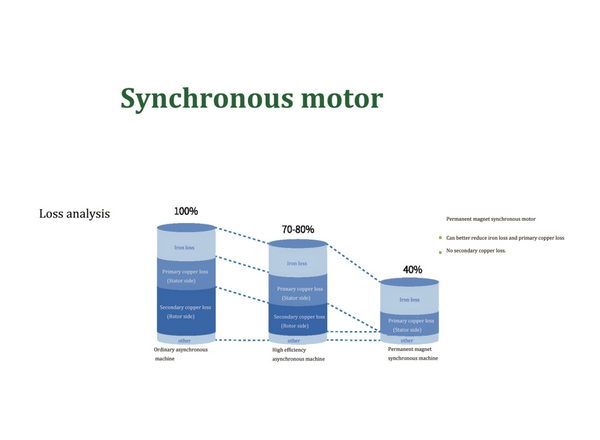1. The AC variable frequency speed control system has significant advantages over the DC speed control system:
1) Easy to adjust speed, save energy and reduce consumption.
2) The AC motor has a simple structure, small size, small inertia, low cost, easy maintenance, and durability.
3) The capacity can be expanded to achieve high speed and high voltage operation.
4) Soft start and quick braking can be achieved.
5) No sparks, explosion-proof, strong environmental adaptability. In recent years, the AC variable frequency speed control transmission has developed at a rate of 13% to 16% per year and has a tendency to gradually replace most of the DC speed control transmission. Due to the limitation of using a constant frequency and constant voltage power supply for ordinary asynchronous motors when applied to variable frequency speed control systems, a special variable frequency AC motor speed system is designed according to the application and usage requirements.
2. Main features of frequency conversion motor
1) B-class temperature rise design, F-class insulation manufacturing. The use of polymer insulating materials, vacuum pressure dipping varnish manufacturing process, and special insulating structure greatly improves the insulation voltage and mechanical strength of electrical windings and is competent for high-speed motor operation and resistance to the high-frequency current impact of inverter and damage to insulation caused by voltage.
2) The balance quality is high, the vibration level is R, the machining precision of mechanical parts is high, and special high-precision bearings are used, which can run at high speed.
3) Forced ventilation cooling system, all imported axial fans are ultra-quiet, long life, and have strong wind. Ensure that the motor is effectively dissipated at any speed, and can achieve high-speed or low-speed long-term operation.
4) Compared with traditional motors, it has a wider range of speed regulation and higher design quality. The special magnetic field design further suppresses the high-order harmonic magnetic field to meet the design indicators of broadband, energy saving, and low noise.
5) With a wide range of constant torque and power speed regulation characteristics, the speed regulation is stable and there is no torque pulsation. It is used in conjunction with various frequency converters and has good parameter matching. With vector control, it can realize zero speed, full torque, low-frequency high torque, high precision speed control, position control, and fast dynamic response control.
6) The special frequency conversion motor can be equipped with brakes and encoders to obtain precise parking, and achieve high-precision speed control through closed-loop speed control.
7) The frequency conversion motor has good versatility, the installation size conforms to the IEC standard, and is interchangeable with the general standard motor. 3. The difference between variable frequency motor and ordinary motor and the control methods of different speeds
3. The difference between variable frequency motor and ordinary motor and the control methods of different speeds
Frequency conversion motors are better than ordinary motors for occasions requiring frequent starting, frequent speed regulation, and frequent braking. Under the variable frequency drive, the efficiency of the variable frequency motor will be increased by about 10%, and the temperature rise will be reduced by about 20%, especially in the low-frequency region of vector control or direct torque control. In terms of electromagnetic noise and vibration, variable frequency motors have lower noise and less electromagnetic vibration than ordinary motors when driven by variable frequency. Since the frequency conversion motor is specially designed for the frequency converter drive, it can withstand larger du/dt, and the insulation strength of the frequency conversion motor is higher, especially in the DTC control mode, which puts forward higher requirements for the insulation strength of the motor.
Under normal circumstances, the variable frequency motor runs continuously with 100% rated load in the range of 10%~100% rated speed, and the temperature rise will not exceed the rated allowable value of the motor. The variable frequency motor mainly solves some problems of ordinary motors running at low speed and high speed. When ordinary motors run at low speed, there are problems with motor heat dissipation and motor bearing strength at high speed.
Most ordinary motors are air-cooled and rely on the rear fan to dissipate heat. When the speed of the motor is low, the heat dissipation of the motor is prone to problems. Compared with ordinary motors, variable frequency motors have obvious advantages. The frequency conversion motor adopts the AC speed regulation method of "special frequency conversion induction motor + frequency converter", which improves the degree of mechanical automation and production efficiency, miniaturizes the equipment, and increases comfort.
4. Conclusion
Using the frequency conversion speed regulation system, the motor can be started at a very low frequency and voltage without inrush current and can be quickly braked by various braking methods provided by the frequency converter to achieve frequent starting and braking. The mechanical system and electromagnetic system of the motor are under the action of cyclic alternating force, which causes accelerated fatigue and aging of the mechanical structure and insulating structure. The requirements of the variable frequency speed control system for the motor are mainly in three aspects: insulation level forced cooling and rotor bearing. If the speed is adjusted above the fundamental frequency, the mechanical strength of the motor structure should also be considered.